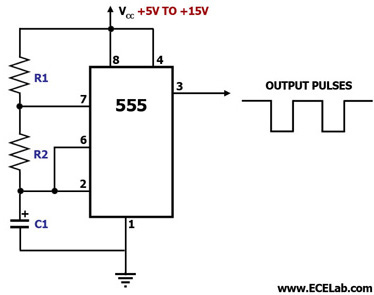Follow along with the video below to see how to install our site as a web app on your home screen.
Note: This feature may not be available in some browsers.
Sir,pls tell me where to join the pin7 and which resistor to be used...thnxHello D@rkL0rd, and welcome to ETO!
The obvious problem I see is that you do not have a resistor going from pin 7 to V+ on the 555 timer. Your current setup will probably not even provide a clock signal to the 4017. Also, is the thick green line (ground) connecting directly to Pin 3? You do NOT want this. Pin 3 should only connect to the 4017 clock input, and nothing else.
Let me know if fixing these errors helps.
Regards,
Matt
Sir,pls tell me where to join the pin7 and which resistor to be used...thnx
yes Sir i will upload an better image...with the logic table given in question...and introducing the resistor blows up the 555 timer it says power dissipiation is much greater 7.2w...Judging by your other values shown on the circuit, and depending on how fast you want it to cycle through, you could probably place another 100k resistor between pin 7 and V+. That should give you a clock period of about 2 seconds. You can reduce the resistor value to increase the frequency, thus speeding up the cycles.
Could we see an image of the circuit while it is not being simulated? I would like to see the rest of the connections without having the colored line overlays--they are quite distracting
Regards,
Matt
yes Sir i will upload an better image...with the logic table given in question...and introducing the resistor blows up the 555 timer it says power dissipiation is much greater 7.2w...
sir i decided to start all over again and doing it in small sub-circuits. starting with the 555 timer producing a pulse every 1 sec...can you please help me with that i tried it but there seems to be some problem...thnxWell no wonder it's saying it's blowing it up. You did not follow my instructions!
Read carefully:
Disconnect R1 from pin 3 (the output). As I told you before, this connection should not be there. The ONLY thing Pin 3 of the 555 timer should be connected to is the clock input of the 4017.
Eliminate R4. The way you connected it is not how I told you to connect it earlier.
Connect the following:
That's all you need to do. Try that and see what happens.
- Connect R1 between pin 6 and pin 7.
- Connect a 100k resistor between pin 7 and V+ (12 volt supply). Alternately, since pin 4 and pin 8 of the 555 are connected to V+, you can just connect the resistor to one of them instead of to V+. It is all the same node
Matt
i will repost after downloading the LtSpice simulator and checking on it..i think there is some problem with the cricuit wizard..thanxLTspice sees no problem with the 555 configuration in post #1. Apart from the pin 7 connection the configuration is a well-known one for generating pulses with a ~50% mark/space ratio. Since pin 7 is an open-collector pull-down output can't it validly be connected to pin3 as originally shown?
I've no idea how CW gets a 7.2W figure for power dissipation. That's at odds with the LTspice sim.
es, i think i can do that that ...thanxWhy not simply copy the oscillator circuit shown on the datasheet of the LM555 or NE555??
i will repost after downloading the LtSpice simulator and checking on it..i think there is some problem with the cricuit wizard..thanx
i tried it but the pulse is not stable for 1 sec ...i think the values sholud be changed...thnxThis is one of the most common astable multivibrator circuits out there for the 555:

Build the above circuit with R1 and R2 being 100k, and C1 being 10uF. Then connect pin 3 to the clock input of the 4017, with your original LED layout.
LTspice sees no problem with the 555 configuration in post #1. Apart from the pin 7 connection the configuration is a well-known one for generating pulses with a ~50% mark/space ratio. Since pin 7 is an open-collector pull-down output can't it validly be connected to pin3 as originally shown?
I've no idea how CW gets a 7.2W figure for power dissipation. That's at odds with the LTspice sim.
The datasheet for a 555 says that it must have supply bypass capacitors from pin 4 to pin 1 that are 0.1uF parallel with a 1uF electrolytic.
Then if it is soldered (not using a solderless breadboard) its frequency will be stable.
NONE of the circuits of the 555 shown on datasheets shows pin 3 connected to pin 7. Why don't you try a circuit that they recommend??
i am a bit confused what is it you want me to add and where...I don't deny that using bypass capacitors would be best, but for all practical purposes for this particular circuit, I don't think the OP will notice much of a difference.
On the other hand, adding 2 capacitors isn't hard, so I guess it's up to him.
